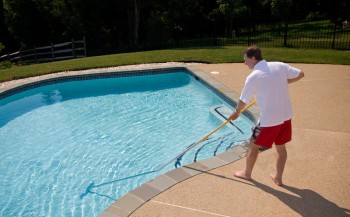
Daily Maintenance
1. Skim Debris from the Pool
It only takes a few minutes, but skimming the surface to remove leaves, bugs, pollen etc. doesn’t just keep your pool looking attractive, it’s an important piece of preventative maintenance.
Most debris that enters a pool floats for 3-4 hours before sinking to the bottom. It brings with it, though, all the nutrients necessary for algae to thrive. And the longer it remains in your pool, the more it decomposes – and the more it depletes the pool’s free chlorine.
I recommend this skimmer net rake here.
2. Empty the Skimmer Baskets
Again, it only takes a minute or two, but, for the same reasons as above, empty the skimmer baskets everyday.
3. Check the Bottom of the Pool
It’s worth a quick visual check to make sure that the last decision made by a passing frog, funnel-web, etc. wasn’t to take a terminal dip in your pool. They play merry hell with your pool’s chemical balance. So, if they’re there, scoop them out, test the pool chemical levels, and adjust if necessary.
4. Check the Pool Water Level
Usually, this takes no more time than a brief glance, but you need to make sure that the water level is sufficiently high for your pump to operate correctly. It should be about halfway up the skimmer. If it’s too low, however, top up the pool.
| *Daily Maintenance Time Saving Tips*Dispose of surface debris and skimmer basket contents well away from the pool so they’re not blown back in.Consider investing in a Solar Breeze Pool Skimmer – a solar-powered, robotic surface skimmer that removes 90-95% of surface debris. It’s cordless and operates independently.Get a pool cover. Pool covers prevents leaves, debris, and most small creatures from entering the pool. Additionally, pool covers reduce evaporation by up to 97%. |
Twice-Weekly Maintenance
Test the Pool Water Chemical Balance
During the summer, check and adjust the chemical balance twice a week. The best time for this is in the early evening. The ideal ranges are:
- pH 7.4-7.6
- Chlorine 1-3 ppm
I recommend these Water Testing Strips or this Liquid Testing Kit here.
Weekly Maintenance
Clean the Pool
I recommend this pool brush and to simplify your vacuuming time you can’t go past a suction vacuum cleaner or a robotic cleaner.
Shock the Pool
Shocking the water once a week by adding a large dose of chlorine eliminates bacteria and other contaminants, and will help prevent potential future problems including algae growth.
Again, the best time to do this is at dusk, with your filter system running overnight.
I recommend this shock treatment.
| *Weekly Maintenance Time Saving Tips*Consider investing in a robotic pool cleaner. For more information, Click Here. Or see our link at the bottom of the page for Recommended products. Get a pool cover. Because pool covers keep debris from entering the pool in the first place, there’s much less to clean up. |
Monthly Maintenance
Test the Pool Water Alkalinity, Calcium Hardness, and Stabiliser (Cyanuric Acid) Levels
If the alkalinity of your pool water is too low it can cause rapid fluctuations in the pH level, thereby making it difficult to control the pH. If alkalinity is too high, it can cause cloudy water and make pH adjustments more difficult. Ideally, alkalinity should be in the range of 80-120 ppm.
Calcium hardness is a measure of all the minerals dissolved in your pool water – principally, calcium, sodium, and magnesium. Low calcium hardness makes the water corrosive, leading to erosion of tile grouting and plaster, and to rusting of metal equipment. High calcium hardness causes scale formation, water clouding, and eye irritation. The ideal range should be 200-400 ppm.
Stabiliser (cyanuric acid) reduces the destructive effect of ultra violet light on chlorine. If the stabiliser level is too low, it only takes a couple of hours of bright sunshine to remove virtually all the chlorine from the water. If the stabiliser is too high, it will inhibit the chlorine from working. However, if maintained at the proper level, between 30-60 parts ppm, stabiliser will increase the natural lifespan of pool water chlorine by anything from 5 to 10 times.
| *Monthly Maintenance Time Saving Tip*Take a sample of the water to a pool dealer for testing. |
Summary Maintenance Schedule
| Daily | Twice-Weekly | Weekly | Monthly |
| Skim the Pool Empty Skimmers Check Pool Bottom Check Water Level |
Test Chemical Balance | Clean the Pool Shock the Pool |
Test for: Alkalinity Calcium Hardness Stabilizer |
Recommended Products
Skimmer Net Rake – for skimming leaves and debris.
Pool Water Testing Strips or Liquid Testing Kit – Test pool water twice a week.
Pool Brush – brush the pool.
Swimming Pool Vacuum – Automatic Suction Cleaner or Robotic Cleaner will make the job easier.
Shock Treatment – shock pool water weekly for healthy water.
Swimming Pool Chlorine – maintain chlorine.
Stabiliser – increase the natural lifespan of pool water chlorine.
Swimming Pool Cover and Pool Cover Roller – reduces the time needed to clean.
Related Reading:
Do You Have Chlorine Lock? How to Unlock & Break It
How Many Chlorine Tablets Do You Get in a Bucket?
How to Neutralize Chlorine in a Pool
How to use Pool Chlorine Test Kits

